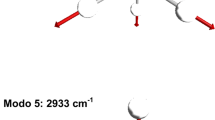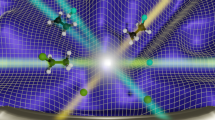Abstract
Over the last decade, advances in quantum dynamics, notably the development of the initial state selected time-dependent wave packet method, coupled with advances in constructing ab initio potential energy surfaces, have made it possible for some four-atom reactions to be addressed from first principles, in their full six internal degrees of freedom. Attempts have been made to extend the time-dependent wave packet method to reactions with more internal degrees of freedom. Here, we review the full-dimensional theory for the A + BCD four-atom reaction and use it to guide the reduced-dimensionality treatment of the X + YCZ3 reaction. Comparison of rigorous calculations with recent experiments are presented for (a) the benchmark H + H2O abstraction reaction, and (b) the H + CH4 → H2 + CH3 reaction.
Access this chapter
Tax calculation will be finalised at checkout
Purchases are for personal use only
Preview
Unable to display preview. Download preview PDF.
Similar content being viewed by others
References
Schatz, G.C. and Kuppermann, A. (1975) Quantum mechanical reactive scattering: An accurate three-dimensional calculation, J. Chem. Phys. 62, 2502–2504.
Elkowitz, A.B. and Wyatt, R.E. (1975) Quantum mechanical reaction cross sections for the three-dimensional hydrogen exchange reaction, J. Chem. Phys. 62, 2504–2506.
Walker, R.B., Stechel, E. and Light, J.C. (1978) Accurate H3 dynamics on an accurate H3 potential surface, J. Chem. Phys. 69, 2922–2923.
Manolopoulos, D.E. and Clary, D.C. (1989) Quantum calculations on reactive collisions, Annu. Rep. Prog. Chem. Sect. C86, 95–118; and references therein.
Miller, W.H. (1990) Recent advances in quantum mechanical reactive scattering theory, including comparison of recent experiments with rigorous calculations of the state-to-state cross sections for the H/D + H2→ H2/HD + H reactions, Annu. Rev. Phys. Chem. 41, 245–281; and references therein.
Clary, D.C. (1991) Quantum reactive scattering of four-atom reactions with nonlinear geometry: OH + H2 → H2O + H, J. Chem. Phys. 95, 7298–7310.
Clary, D.C. (1992) Bond-selected reaction of HOD with H atoms, Chem. Phys. Lett. 192, 34–40.
Wang, D. and Bowman, J.M. (1992) Reduced dimensionality quantum calculations of mode specificity in OH + H2 ↔ H2O + H, J. Chem. Phys. 96, 8906–8913.
Yang, M., Zhang, D.H., Collins, M.A. and Lee, S.-Y. (2001) Quantum dynamics on new potential energy surfaces for the H2 + OH→ H2O + H reaction, J. Chem. Phys. 114, 4759–4762.
Zhang, D.H., Yang, M. and Lee, S.-Y. (2002) Quantum dynamics of the D2 + OH reaction, J. Chem. Phys. 116, 2388–2394.
Zhang, D.H., Yang, M. and Lee, S.-Y. (2002) Accuracy of the centrifugal sudden approximation in the H + H2O reaction and accurate integral cross sections for the H + H2O → H2 + OH abstraction reaction, J. Chem. Phys. 117, 10067–10072.
Zhang, D.H., Xie, D., Yang, M. and Lee, S.-Y. (2002) State-to-state integral cross section for the H + H2O→ H2 + OH reaction, Phys. Rev. Lett. 89, 283203 (1–4).
Zhang, D.H. and Zhang, J.D.H. (1993) Accurate quantum calculations for the benchmark reaction H2 + OH → H2O + H in five-dimensional space: Reaction probabilities for J = 0, J. Chem. Phys. 99, 5615–5618.
Zhang, D.H. and Zhang, J.D.H. (1994) Accurate quantum calculations for H2 + OH → H2O + H: Reaction probabilities, cross sections and rate constants, J. Chem. Phys. 100, 2697–2706.
Huarte-Larranaga, F. and Manthe, U. (2000) Full dimensional quantum calculations of the CH4 + H→CH3 + H2 reaction rate, J. Chem. Phys. 113, 5115–5122.
Huarte-Larranaga, F. and Manthe, U. (2001) Quantum dynamics of the CH4 + H→CH3 + H2 reaction: Full dimensional and reduced dimensionality rate constants, J. Phys. Chem. A 105, 2522–2529.
Huarte-Larranaga, F. and Manthe, U. (2002) Vibrational excitation in the transition state: The CH4 + H →CH3 + H2 reaction rate constant in an extended temperature interval, J. Chem. Phys. 116, 2863–2869.
Meyer, H.D., Manthe, U. and Cederbaum, L.S. (1990) The multiconfigurational time-dependent Hartree approach, Chem. Phys. Lett. 165, 73–78.
Beck, M.H., Jackle, A., Worth, G.A. and Meyer, H.D. (2000) The multiconfigurational time-dependent Hartree (MCTDH) method: a highly efficient algorithm for propagating wavepackets, Phys. Rep. 324, 1–105; and references therein.
Sukiasyan, S. and Meyer, H.D. (2002) Reaction cross sections for the H + D2 (v0=1) → HD + D and D + H2 (v0=1) → DH + H systems. A multiconfigurational time-dependent Hartree (MCTDH) wave packet propagation study, J. Chem. Phys. 116, 10641–10647.
Clary, D.C. (1994) Four-atom reaction dynamics, J. Phys. Chem. 98, 10678–10688.
Clary, D.C. (1995) Product CN Rotational Distributions from the H + HCN reaction, J. Phys. Chem. 99, 13664–13669.
Clary, D.C. and Palma, J. (1997) Quantum dynamics of the Walden inversion reaction Cl− + CH3Cl → ClCH3 + Cl−, J. Chem. Phys. 106, 575–583.
Wang, D. and Bowman, J.M. (2001) A reduced dimensionality, six-degree-of-freedom, quantum calculation of the H + CH4 → H2+ CH3 reaction, J. Chem. Phys. 115, 2055–2061.
Bowman, J.M. (2002) Overview of reduced dimensionality quantum approaches to reactive scattering, Theo. Chem. Acc. 108, 125–133; and references therein.
Yu, H. and Nyman, G. (1999) Four-dimensional quantum scattering calculations on H + CH4 → H2+ CH3 reaction, J. Chem. Phys. 111, 3508–3516.
Yu, H. and Nyman, G. (2000) Quantum dynamics of the O(3P) + CH4 → OH + CH3 reaction: An application of the rotating bond umbrella model and spectral transform subspace iteration, J. Chem. Phys. 112, 238–247; and references therein.
Zhang, J.Z.H. (1999) The semirigid vibrating rotor target model for quantum polyatomic reaction dynamics, J. Chem. Phys. 111, 3929–3939.
Zhang, D.H. and Zhang, J.Z.H. (2000) The semirigid vibrating rotor target model for atom-polyatom reaction: Application to H + H2O → H2 + OH, J. Chem. Phys. 112, 585–591.
Wang, M.L. and Zhang, J.Z.H. (2002) Generalized semirigid vibrating rotor target model for atom-polyatom reaction: Inclusion of umbrella mode for the H + CH4 reaction, J. Chem. Phys. 117, 3081–3087; and references therein.
Sutherland, J.W., Su, M.-C. and Michael, J.V. (2001) Rate constants for H + CH4, CH3 + H2, and CH4 dissociation at high temperature, Int. J. Chem. Kinet. 33, 669–684; and references therein.
Bryukov, M.G., Slagle, I.R. and Knyazev, V.D. (2001) Kinetics of reactions of H atoms with methane and chlorinated methanes, J. Phys. Chem. 105, 3107–3122.
Takayanagi, T. (1996) Reduced dimensionality calculations of quantum reactive scattering for the H + CH4 → H2+ CH3 reaction, J. Chem. Phys. 104, 2237–2242.
Bowman, J.M., Wang, D., Huang, X., Huarte-Larranaga and Manthe, U. (2001) The importance of an accurate CH4 vibrational partition function in full dimensionality calculations of the H + CH4 → H2+ CH3 reaction, J. Chem. Phys. 114, 9683–9684.
Pu, J. and Truhlar, D.G. (2002) Parametrized direct dynamics study of rate constants of H with CH4 from 250–2400K, J. Chem. Phys. 116, 1468–1478.
Palma, J., Echave, J. and Clary, D.C. (2002) Rate constants for the CH4 + H→ CH3 + H2 reaction calculated with a generalized reduced-dimensionality method, J. Phys. Chem. A 106, 8256–8260.
Yang, M., Zhang, D.H. and Lee, S.-Y. (2002) A seven-dimensional quantum study of the H + CH4 reaction, J. Chem. Phys. 117, 9539–9542.
Rose, M.E. (1957) Elementary Theory of Angular Momentum, Wiley, New York.
Fleck, Jr., J.A., Morris, J.R. and Feit, M.D. (1976) Time-dependent propagation of high energy laser beams through the atmosphere, Appl. Phys. 10, 129–160.
Palma, J. and Clary, D.C. (2000) A quantum model Hamiltonian to treat reactions of the type X + YCZ3 → XY + CZ3: Application to O(3.P) + CH4 → OH + CH3, J. Chem. Phys. 112, 1859–1867.
Zhang, J.Z.H. (1999) Theory and Applications of Quantum Molecular Dynamics, World Scientific, Singapore.
(a) Walch, S.P. and Dunning, T.H. (1980) A theoretical study of the potential energy surface forOH + H2, J. Chem. Phys. 72, 1303–1311; (b) Schatz, G.C. (1981) A quasiclassical trajectory study of reagent vibrational excitation effects in the OH + H2 → H2O + H reaction, J. Chem. Phys. 74, 1133–1139; (c) Elgersma, H. and Schatz, G.C. (1981) A quasiclassical trajectory study of mode specific reaction rate enhancements in H + H2O(v1, v2, v3) → OH + H2, Intl. J. Quantum Chem., Quantum Chem. Symp. 15, 611–619.
Bettens, R.P., Collins, M.A., Jordan, M.J.T. and Zhang, D.H. (2000) Ab initio potential energy surface for the reactions between H2O and H, J. Chem. Phys. 112, 10162–10172.
Zhang, D.H., Collins, M.A. and Lee, S.-Y. (2000) First principles theory for the H + H2O, D2O reactions, Science 290, 961–963.
(a) Yang, M., Zhang, D.H., Collins, M.A. and Lee, S.-Y. (2001) Quantum dynamics on new potential energy surfaces for the H2 + OH → H2O + H reaction J. Chem. Phys. 114, 4759–4762; (b) ibid. (2001) Ab initio potential energy surfaces for the reactions OH + H2 ↔ H2O + H, J. Chem. Phys. 115,174–178.
Collins, M.A. (2002) Molecular potential energy surfaces for chemical reaction dynamics, Theor. Chem, Acc. 108, 313–324.
Steckler, R., Dykema, K.J., Brown, F.B., Hancock, G.C., Truhlar, D.G. and Valencich, T. (1987) A comparative study of potential energy surfaces for CH3+ H2↔ CH4 + H, J. Chem. Phys. 87, 7024–7035; and references therein.
Jordan, M.J.T. and Gilbert, R.G. (1995) Classical trajectory studies of the reaction CH4 + H→ CH3 + H2, J. Chem. Phys. 102, 5669–5682.
Joseph, T.R., Steckler, R. and Truhlar, D.G. (1987) A new potential energy surface for the CH3 + H2 ↔ CH4 + H reaction: Calibration and calculation of rate constants and kinetic isotope effects by variational transition state theory and semi-classical tunneling calculations, J. Chem. Phys. 87, 7036–7049.
Duchovic, R.J., Hase, W.L. and Schlegel, H.B. (1984) Analytic function for the H + CH3 ↔ CH4 potential energy surface, J. Phys. Chem. 88, 1339–1347.
Zhang, D.H., Yang, M., Lee, S.-Y. and Collins, M.A. (2003) Quantum dynamics study of the H + CH4 → H2 + CH3 reaction (in preparation).
Zhang, D.H., Yang, M. and Lee, S.-Y. (2002) Breakdown of the spectator model for the OH bonds in studying the H + H2O reaction, Phys. Rev. Lett. 89, 103201 (1–4).
Castillo, J.F., Aoiz, F.J. and Banares, L. (2002) A quasiclassical trajectory study of the H + H2O → OH + H2 reaction dynamics at 1.4 eV collision energy on a new ab initio potential energy surface, Chem. Phys. Lett. 356, 120–126.
Brouard, M., Burak, I., Marinakis, S., Minayev, D., O’Keefe, P., Vallance, C., Aoiz, F.J., Banares, L., Castillo, J.F., Zhang, D.H., Xie, D., Yang, M., Lee, S.-Y. and Collins, M.A. (2003) Cross section for the H + H2O abstraction reaction: Experiment and theory, Phys. Rev. Lett. 90, 93201 (1–4).
Troya, D., Gonzalez, M. and Schatz, G.C. (2001) A quasiclassical trajectory study of reactivity and product energy disposal in H + H2O, H + D2O and H + HOD, J. Chem. Phys. 114, 8397–8413.
(a) Wu, G., Schatz, G.C., Lendvay, G., Fang, D.C. and Harding, L.B. (2000) A new potential energy surface and quasiclassical trajectory study of H + H2O → OH + H2, J. Chem. Phys. 113, 3150–3161; (b) ibid. (2000) Erratum, J. Chem. Phys. 113, 7712.
Author information
Authors and Affiliations
Editor information
Editors and Affiliations
Rights and permissions
Copyright information
© 2004 Kluwer Academic Publishers
About this paper
Cite this paper
Zhang, D.H., Yang, M., Collins, M.A., Lee, SY. (2004). Reaction Dynamics of Polyatomic Systems: FROM A + BCD → AB + CD to X + YCZ3 → XY + CZ3. In: Lagana, A., Lendvay, G. (eds) Theory of Chemical Reaction Dynamics. NATO Science Series II: Mathematics, Physics and Chemistry, vol 145. Springer, Dordrecht. https://doi.org/10.1007/1-4020-2165-8_13
Download citation
DOI: https://doi.org/10.1007/1-4020-2165-8_13
Publisher Name: Springer, Dordrecht
Print ISBN: 978-1-4020-2055-1
Online ISBN: 978-1-4020-2165-7
eBook Packages: Chemistry and Materials ScienceChemistry and Material Science (R0)




